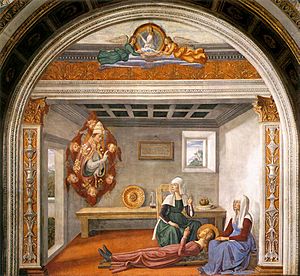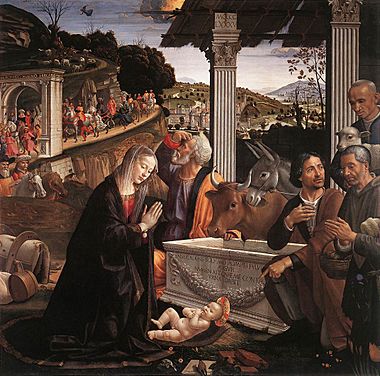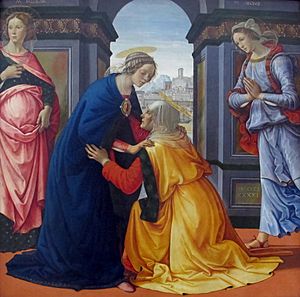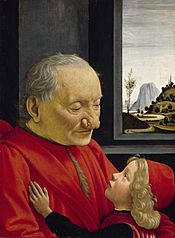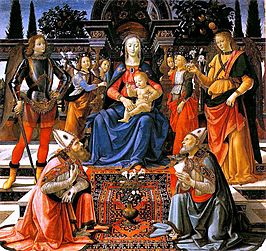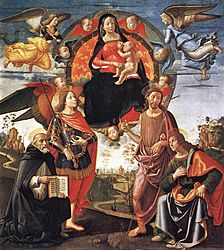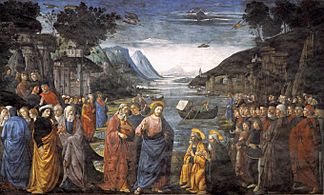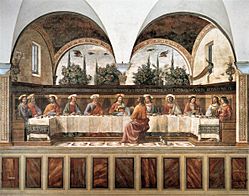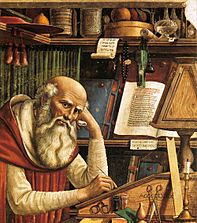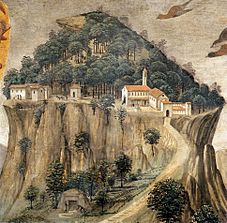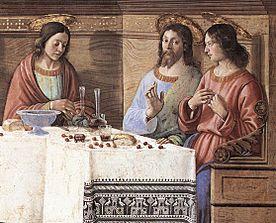Domenico Ghirlandaio facts for kids
Quick facts for kids
Domenico Ghirlandaio
|
|
|---|---|

Considered a self-portrait
from Adoration of the Magi, 1488 |
|
| Born |
Domenico di Tommaso Curradi di Doffo Bigordi
2 June 1448 Florence, Republic of Florence
|
| Died | 11 January 1494 (aged 45) Florence, Republic of Florence
|
| Resting place | Basilica of Santa Maria Novella |
| Nationality | Italian |
| Known for | Painter |
|
Notable work
|
Paintings in: Church of Ognissanti, Palazzo Vecchio, Santa Trinita, Tornabuoni Chapel in Florence and Sistine Chapel, Rome |
| Movement | Italian Renaissance |
Domenico Ghirlandaio (born Domenico di Tommaso Curradi di Doffo Bigordi, June 2, 1448 – January 11, 1494) was a famous Italian Renaissance painter from Florence. He was part of an important group of artists in Florence, including Verrocchio and Sandro Botticelli.
Ghirlandaio ran a large and busy workshop. His brothers, Davide Ghirlandaio and Benedetto Ghirlandaio, and his brother-in-law, Bastiano Mainardi, worked with him. Later, his son Ridolfo Ghirlandaio also joined. Many young artists learned from Ghirlandaio, including the very famous Michelangelo. Ghirlandaio was especially good at painting scenes from everyday life and portraits of real people within religious stories. This made him very popular and helped him get many big art jobs.
Contents
Life and Works
Early Years
Domenico Ghirlandaio was born in Florence. His father was a goldsmith. Domenico got his nickname "Il Ghirlandaio," which means "the garland-maker," from his father. His father was known for making beautiful metal garlands that Florentine women wore on their heads.
According to an old story by Giorgio Vasari, Domenico started by helping his father. He loved to draw people who visited the shop. He was very good at capturing their likeness right away. Later, he became an apprentice to learn painting and mosaic art. He also worked closely with other Florentine painters like Botticelli.
First Works in Florence, Rome, and Tuscany
Ghirlandaio was excellent at painting frescos, which are paintings done on wet plaster walls. These large wall paintings are what he is most famous for.
One of his first big jobs was in the 1470s in San Gimignano. He decorated the Santa Fina Chapel in the Collegiate Church. These frescos, painted around 1477-1478, show two amazing events linked to the death of Saint Fina.
In 1480, Ghirlandaio painted St. Jerome in His Study for the Church of Ognissanti, Florence. He also painted a large Last Supper in the church's dining hall. From 1481 to 1485, he worked on frescos in the Palazzo Vecchio. One of these was an Apotheosis of St. Zenobius (1482). This painting was very impressive with its detailed architecture and figures.
In 1481, Pope Sixtus IV called Ghirlandaio to Rome. He was part of a team of painters who created frescos in the famous Sistine Chapel. Ghirlandaio painted The Calling of the Apostles. He also painted a Resurrection of Christ, which is now lost. His brother-in-law, Sebastiano Mainardi, helped him with these important projects.
Later Works in Tuscany
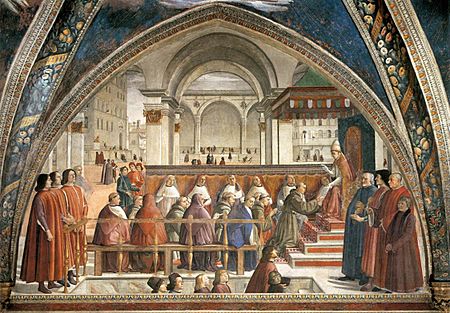
Between 1482 and 1485, Ghirlandaio painted a series of frescos in the Sassetti Chapel in Santa Trinita. He did this for a rich banker named Francesco Sassetti. The paintings showed six scenes from the life of Saint Francis of Assisi. One painting shows Lorenzo de' Medici, Sassetti, and Lorenzo's children. Another painting in this series even includes a self-portrait of Ghirlandaio himself.
Around this time, a famous painting from the Netherlands arrived in Florence. It was called the Portinari Altarpiece. This painting was made with oil paints, which was new for Florence. It showed how oil paint could create amazing textures and light effects. Ghirlandaio was especially impressed by how real the shepherds looked in this painting.
In 1485, Ghirlandaio painted the main altarpiece for the Sassetti Chapel, called Adoration of the Shepherds. In this painting, you can see how much he learned from the Portinari Altarpiece. The shepherds, including a self-portrait of Ghirlandaio, look very real. This was a big step forward in Florentine painting.
Right after the Sassetti Chapel, Ghirlandaio was asked to paint new frescos in the choir of the Basilica of Santa Maria Novella. This area was the chapel of the Ricci family, but the powerful Tornabuoni and Tornaquinci families paid for the work. The Tornabuoni Chapel frescos were painted between 1485 and 1490. They showed scenes from the lives of the Virgin Mary and St. John the Baptist.
In these frescos, there are more than twenty portraits of the Tornabuoni and Tornaquinci families. One painting, Angel appearing to Zacharias, includes portraits of famous thinkers like Agnolo Poliziano and Marsilio Ficino. The Tornabuoni Chapel was finished in 1490. Ghirlandaio also designed a stained glass window for it.
Even though he was known for frescos, Ghirlandaio also painted many altarpieces. These include the Virgin Adored by Saints Zenobius, Justus and Others and the Adoration of the Magi for a Florentine orphanage. In the orphanage painting, he again included a self-portrait. His Visitation, now in the Louvre, is one of his last known works, dated 1491.
Ghirlandaio also painted many portraits of real people. One famous one is his profile portrait of Giovanna Tornabuoni from 1488. Perhaps his most famous is the Portrait of an Old Man and his Grandson. It's special because it shows such tender feelings and a very realistic depiction of the old man's nose.
Death
Domenico Ghirlandaio died on January 11, 1494, from a serious illness. He was buried in Santa Maria Novella. He had been married twice and left six children. One of his sons, Ridolfo Ghirlandaio, also became a painter.
Legacy
Ghirlandaio mainly worked with frescos, but he also created important paintings using tempera paint. He was known for being one of the first artists to stop using too much gold in his paintings. Instead, he painted gold objects to make them look real.
People praised Ghirlandaio for his great compositions and his excellent use of light and shadow. He was also very good at perspective, which is making things look three-dimensional on a flat surface. He could draw ancient Roman buildings like the Colisseum just by looking at them, and his drawings were mathematically accurate.
Ghirlandaio is famous for being the teacher of Michelangelo. Another one of his students was Francesco Granacci. According to Vasari, Ghirlandaio sent these two best students to the Medici Academy when Lorenzo de' Medici asked for them. Even though Michelangelo became famous as a sculptor, he followed his teacher's path by painting frescos in the Sistine Chapel.
Many art experts have praised Ghirlandaio. They admired his compositions, his technical skills, and how lifelike his figures were. His paintings are also very useful for historians because they show what life was like in Florence during his time.
Works by Ghirlandaio
Portraits
Altarpieces
Frescos
Details
See also
 In Spanish: Domenico Ghirlandaio para niños
In Spanish: Domenico Ghirlandaio para niños
- Davide Ghirlandaio
- Benedetto Ghirlandaio
- Ridolfo Ghirlandaio


